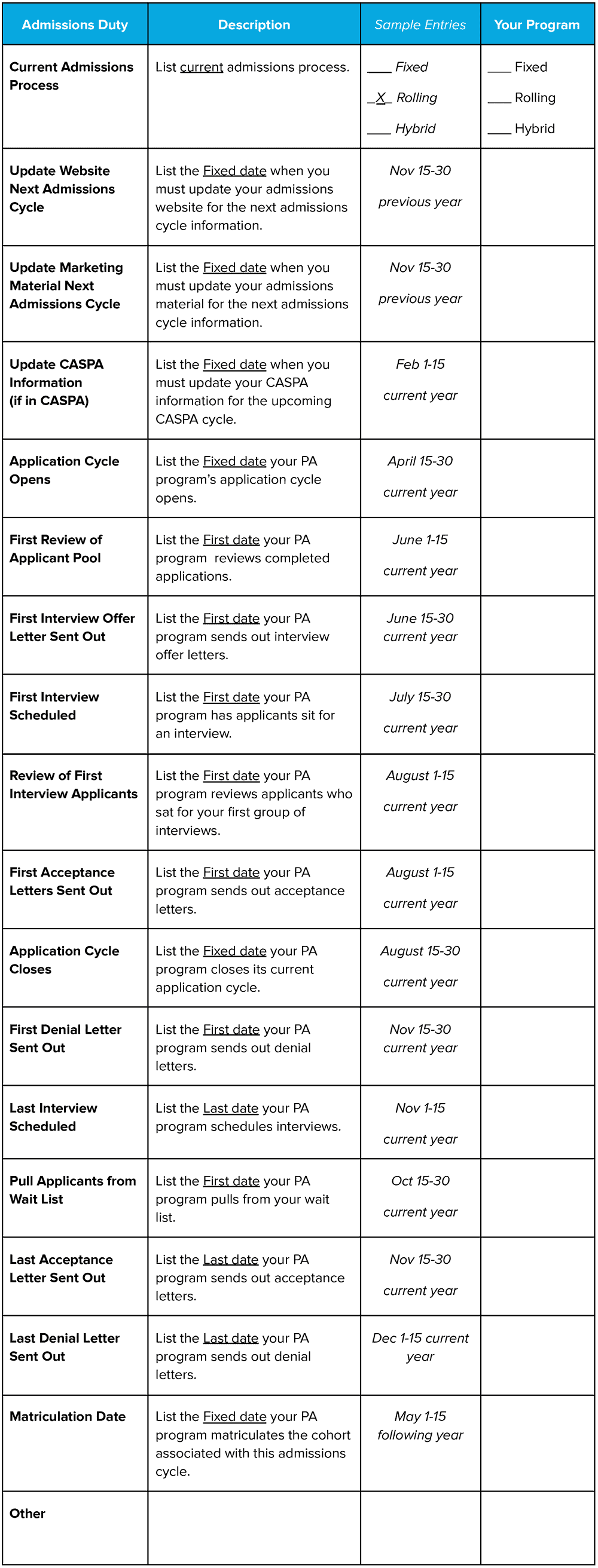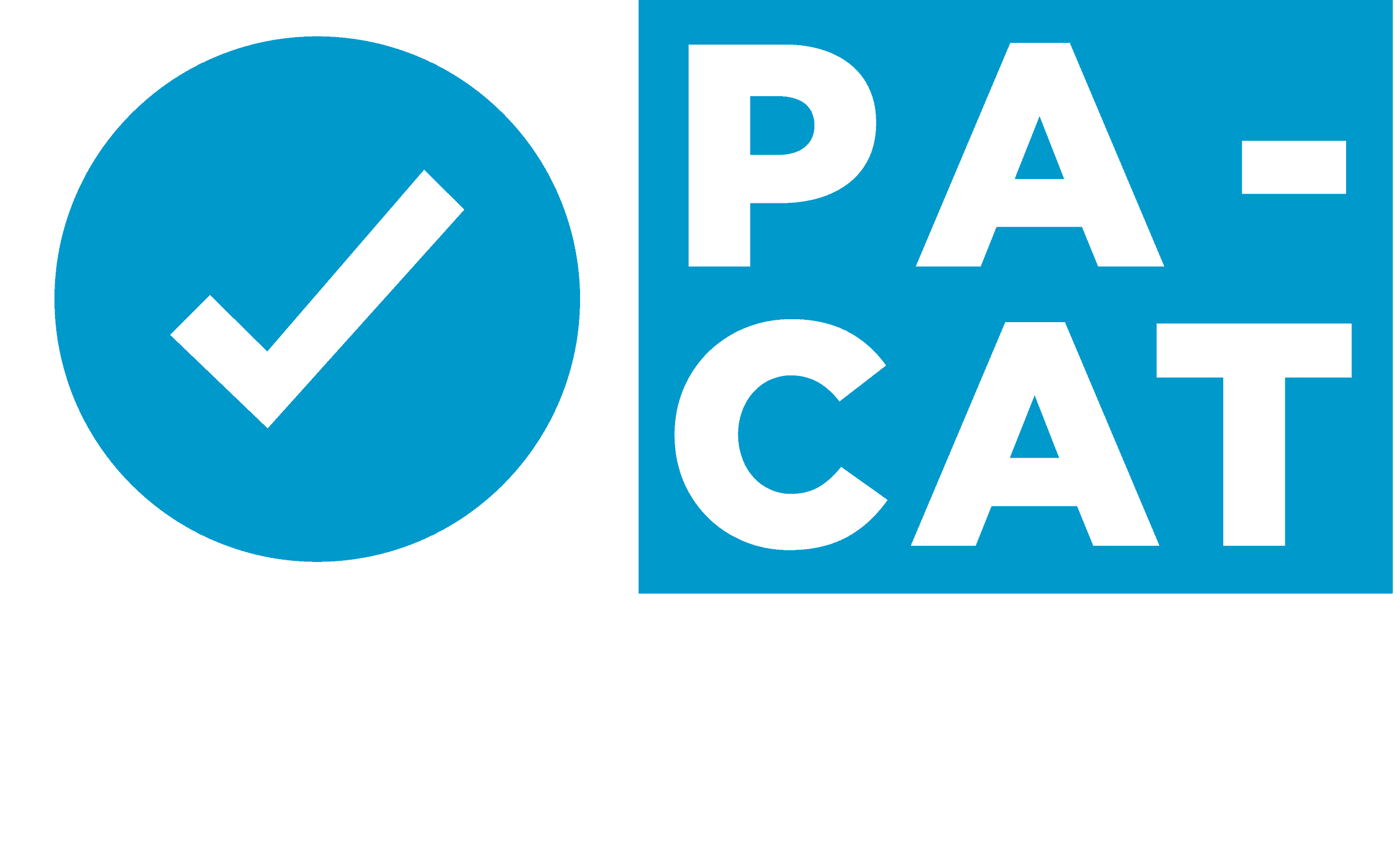ISSUE 12
Managing PA Admissions Personnel Part 1: Creating the Key Admissions Duty Timeline
By Jim Pearson and Dr. Scott Massey
Welcome back to PA Admissions Corner. In our last issue, we covered the basics of helping your applicants to get to know, like, and trust your program through a transactional lens with the applicant as a customer. But the troubling truth is that even if applicants are clamoring for admission, without a good staff to organize, review, and manage admissions data, meeting goals and filling seats will be challenging.
The next few Issues of PA Admissions Corner will revolve around your personnel and how to manage and develop their workflow. Can they handle the duties within your admissions cycle that have the highest impact on your admissions outcome?
Many PA programs understandably feel that they do not have enough time to review, evaluate, process, and properly select interview applicants from their total applicant pool, whether it’s 400 or 1400 applicants. They often end up choosing the wrong applicants for interviews and acceptance offers; many of whom back out and enroll elsewhere. The program then scrolls further down the waitlist to fill the incoming cohort with applicants who may not be fully qualified.
The first task is to restructure your admissions department’s workflow to overcome the logistical issues with the greatest potential to affect your admissions outcomes.
List Your PA Program Key Admissions Duties
All admissions departments develop patterns for their duties, timelines, and procedures. Many patterns are necessary and beneficial to your admissions department’s outcomes, but others ultimately become counterproductive to ongoing admissions goals.
A key self-discovery question we’ve asked hundreds of admissions directors while working with them to strengthen their program’s outcomes is, “Why are you doing this specific task or duty this way?” As the director, answer this question for all practices and procedures, then determine if adjustments are needed.
The Key Admissions Duty Timelines table we put together will help you with this task. Read the instructions below, then complete the exercises in the table.
- All data requested in this table is only for your PA program’s current application cycle and does not have any connection to when CASPA opens and closes if you are using that application processing portal.
- If specific duties are performed during the year before your cycle opens, list the previous year’s month ( “previous Nov”). If specific duties are performed during the year after your cycle opens, list the following year’s month ( “following Jan”).
- Some admissions duties will vary by a few days or weeks each calendar year, so list these dates in a 15-day range (for example, “CASPA opens April 15-30,” or “First Interview scheduled July 15-30”).
Key Admissions Duty Timeline
In the table below (download & print), list your PA program’s dates for the following key admissions workflow duties:

What Dates Do You Control?
As you review your PA program’s Key Admissions Duty Timeline, you will notice certain dates that you have limited or no control over; ARC-PA controls your matriculation date, and you must follow CASPA’s due dates, for example.
Many key admissions duty dates you can control, however, like the start and end of your admissions cycle, your interview cycle, and when acceptance letters are sent.
Why is this control important? Timelines used by most PA programs have changed drastically over the last five to seven years. PA program application cycles generally used to open in April and close in October. They would screen all their applicants, run two to four interview sessions in October and November, then select the students to fill the next matriculation’s cohort. There was no concern about diving deep into the wait list or having open seats on the start date.
Today, that kind of schedule will leave you far behind the competition; you may be inadvertently denying yourself access to 50% or more of your total applicant pool.
How Do Your Admission Duty Dates Compare?
Based on extensive discussions with over 150 PA programs about their admissions processes, here are some admissions trends we have observed:
- Over 80% of all PA programs start their admissions cycle to mirror the opening of CASPA each spring (late April, early May) and end it by October.
- Over 70% of all PA programs now use a rolling admissions process, leading most PA Programs to front-load their student selection decision-making. Everyone is moving to the front and condensing their decision-making timeline.
- Most PA programs who start their admissions cycle with the opening of CASPA and use a rolling admissions process start their initial interviews in June or no later than July.
- By the end of August each year, most PA programs using a rolling process have filled close to 90% of their next cohort’s seats.
- By the end of August, over 50% of the nationally available seats have been filled. Within certain competitive geographical areas, that percentage can be much higher.
- Many PA programs now fill all upcoming cohort seats before closing their current admissions cycle.
- Most of the higher-qualified applicants will have been selected by another PA program before those applicants would even have a chance to speak with programs that wait until early fall to start interviewing.
If your current admissions duty timelines aren’t keeping up with your main competitors, your program is at a distinct disadvantage. Consider what adjustments can realign your admissions processes to be more competitive.
Further Uses for Admissions Duty Timelines
The data you entered in your chart can also be helpful to—
- have a good snapshot of your whole admissions cycle from start to finish.
- determine specific times during the calendar year when certain stresses will be placed on faculty and staff; you can modify duties and responsibilities to facilitate better performance.
- determine how some of your key admissions cycle duties compare to your competition and to national trends, urging other potential adjustments.
NEXT TIME…
As we continue this series on Managing PA Admissions Personnel in Issue 13, we’ll help you conduct an employee ranking survey to determine if you have the right people in the right roles.
To your admissions and program success,
Jim Pearson, CEO
Exam Master
Dr. Scott Massey Ph.D., PA-C
Scott Massey LLC
Exam Master supports Physician Assistant Educational Institutions with the following services:
- Admissions Support Services
- PA-CAT Admissions Exam
- Pre-Matriculation Program
- Admissions Consulting
- Student Progression
- Student Success Study Skills Program
- Data Analytics
- Accreditation Support
- Board Preparation
- Emory Clinical Review Program
- PANCE Board Review Program
For information on any of the above products and/or services, contact Jim Pearson.

